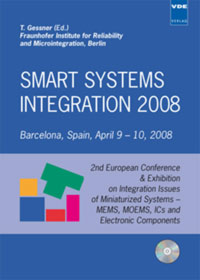Integration of an elasotmer in micromachining technology
Conference: Smart Systems Integration 2008 - 2nd European Conference & Exhibition on Integration Issues of Miniaturized Systems - MOMS, MOEMS, ICS and Electronic Components
04/09/2008 - 04/10/2008 at Barcelona, Spain
Proceedings: Smart Systems Integration 2008
Pages: 4Language: englishTyp: PDF
Personal VDE Members are entitled to a 10% discount on this title
Authors:
Soulimane, S.; Charlot, S.; Bourrier, D.; Bancaud, A.; Gué, A.-M.; Camon, H. (LAAS-CNRS, Paul Sabatier University, Toulouse, France)
Sudor, J. (CEA-Leti/MINATEC, Grenoble, France)
Abstract:
In recent years, electroactive polymers "EAP" have emerged with great potential to enable unique mechanisms, which can emulate muscle. Dielectric elastomers have yielded extremely large strain and elastic energy density suggesting that they are useful for many actuator applications. Dieletric EAP actuators combine in an exceptional way high energy-density, while allowing large amplitude displacements. In DEAP, actuation is obtained by applying a voltage to a sheet of elastomer covered on each side by conductive electrodes. The electrostatic force squeezes the polymer, decreasing the sheet’s thickness and increasing its surface, due to the constant-volume property of elastomers EAP actuators are considered as the least developed technology and extensive effort is required to bring it to a mature stage. Efforts are needed to gain a better understanding of the parameters that control the electromechanical interaction critical challenges that cannot be address with current technology. To overcome this limitation there is a need for development in numerous multidisciplinary areas from computational chemistry, comprehensive material science, electromechanic analysis and particularly improved material processing techniques.


